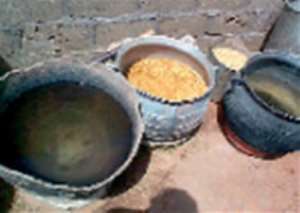
Many communities in northern Ghana are strongly patrilineal by tradition.
Equipment for parboiling oflocal rice in Northern Ghana.
Only men can own land or dictate farming practices for the family. But in certain areas of northern Ghana, it is women who are ensuring the survival of one of the most important crops grown in the country: rice. The women have continued to cultivate traditional varieties of African rice in the face of increased reliance on improved varieties by the men of their communities.
African rice has high gluten content, a nutty taste, and is so filling when cooked that it is often regarded as an important component of meals. Local varieties of African rice are also highly resistant to drought and crop diseases. But in many communities, the men often choose to "modernize" by planting improved strains of Asian rice that, while they might be higher yielding and produce greater economic returns, lack the cultural significance and possibly the nutritional content of traditional varieties. The improved varieties are not parboiled before milling and many researchers believe that parboiled rice retains more protein, vitamins, and minerals and is more nutritious than raw milled rice.
The farmers of Gore, in the Bawku District of the Upper East Region of Ghana, are representative of the trend towards new varieties. In Gore, where land belongs to male farmers, only small plots are given to women; these tend to be water logged or infertile. Nevertheless, more women cultivate rice than men, and their fields tend to be better managed than those of the male farmers. According to surveys conducted by the University for Development Studies, Tamale in Ghana and the Savannah Agricultural Research Institute in 2001-2002, women could also describe the characteristics of many more rice varieties than their male counterparts.
Women farmers consider traditional rice varieties to be superior to modern varieties in several ways. Traditional rice requires only a short cooking time, suitable for the preparation of dishes such as waakye (cooked rice and beans) and rice balls. Traditional varieties perform well without expensive inputs such as the fertilizers and pesticides applied to most of the types introduced in Ghana over the past 30 or more years. They can also be cultivated in the adverse conditions of drought or floods.
Traditional rice varieties are economically important, most noticeably for parboiling. Parboiled rice is cooked briefly in boiling water and then submerged in ice-cold water to stop the cooking. Parboiled rice from the region commands a high price on the market due to its cooking quality. Thousands of women in northern Ghana increase their income by participating in the parboiled rice industry.
The women farmers of Gore name each rice variety they cultivate. Some varieties are named for the farmers who first introduced them to the community: Mariama, Peter and Mr. Moore. Agona is a variety originating from the town with the same name in the Ashanti region of Ghana. Other varieties are named for the size and shape of their grain. For instance, Agongula means "short grain of rice" in the local Kusal language, and Mui-sablic refers to the black colour of the husk. One variety's name means "help me buy a dress" in the local language.
Each year, farmers plant their fields from seed reserved from the previous harvest. Some buy seed at the market or exchange with other villages from as far away as Burkina Faso and Togo. Others exchange seed locally with relatives, colleagues and friends. Women who mill small quantities of rice at the local mill often exchange seeds to try a new variety. Farmers also keep small quantities of seed in store after planting to avoid total loss of the material.
The women of Gore have made a conscious choice to maintain their traditional agricultural system. To us, their decision is a boon for biodiversity conservation; to them, it is just a logical continuation of a system that has worked for many years.
This story arose from work supported by a UNEP-GEF grant concerned with identifying the traditional practices that support the conservation of landraces in arid and semi-arid ecosystems in Africa. The aim of the project is to determine how national agricultural policies can better support traditional farming systems.
By G. Kranjac-Berisavljevic, University for Development Studies, Tamale, Ghana and P.B. Tanzubil, Savanna Agricultural Research Institute, Bawku, Manga, Ghana




 There’s nothing you can do for us; just give us electricity to save our collapsi...
There’s nothing you can do for us; just give us electricity to save our collapsi...
 Ghanaian media failing in watchdog duties — Sulemana Braimah
Ghanaian media failing in watchdog duties — Sulemana Braimah
 On any scale, Mahama can't match Bawumia — NPP Youth Organiser
On any scale, Mahama can't match Bawumia — NPP Youth Organiser
 Never tag me as an NPP pastor; I'm 'pained' the 'Akyem Mafia' are still in charg...
Never tag me as an NPP pastor; I'm 'pained' the 'Akyem Mafia' are still in charg...
 Your refusal to dedicate a project to Atta Mills means you never loved him — Kok...
Your refusal to dedicate a project to Atta Mills means you never loved him — Kok...
 2024 elections: I'm competent, not just a dreamer; vote for me — Alan
2024 elections: I'm competent, not just a dreamer; vote for me — Alan
 2024 elections: Forget NPP, NDC; I've the Holy Spirit backing me and nothing wil...
2024 elections: Forget NPP, NDC; I've the Holy Spirit backing me and nothing wil...
 2024 elections: We've no trust in judiciary; we'll ensure ballots are well secur...
2024 elections: We've no trust in judiciary; we'll ensure ballots are well secur...
 Performance tracker: Fire MCEs, DCEs who document Mahama's projects; they're not...
Performance tracker: Fire MCEs, DCEs who document Mahama's projects; they're not...
 Train crash: Railway ministry shares footage of incident
Train crash: Railway ministry shares footage of incident
